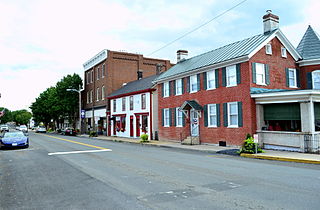
Strasburg Historic District is a national historic district located at Strasburg, Shenandoah County, Virginia. The district encompasses 206 contributing buildings and 1 contributing site in the town of Strasburg. It includes a variety of commercial, residential, and institutional buildings dating from the 18th to 20th centuries. Notable buildings include the George Eberly House, Presbyterian Church, Alton House, Spengler Hall, Spengler's Mill (1794), Bell Pottery (pre-1878), Strasburg Christian Church, Strasburg Methodist Church (1905), St. Paul's Lutheran Church (1892), First National Bank, Home Theatre (1930s), Strasburg School (1910) and the Sonner House (1757).

Richlands Historic District is a national historic district located at Richlands, Tazewell County, Virginia. The district encompasses 91 contributing buildings in the central business district of the town of Richlands. It includes residential, commercial, and institutional buildings dating from the late-19th to mid-20th centuries. Notable buildings include the W.B.F. White and Sons Hardware building, Bank of Richlands, Norfolk and Western Railroad Section House, First Christian Church (1908), First United Methodist Church, and Richlands Presbyterian Church. Also located in the district is the separately listed Clinch Valley Coal and Iron Company Office.

West Point Historic District is a national historic district located at West Point, King William County, Virginia. The district encompasses 75 contributing buildings and 1 contributing object in the town of West Point. The district includes residential, commercial, and institutional buildings and is notable for its variety of late-19th- and early-20th-century styles and building types. Notable buildings include the William Mitchell House, Anderson-Mayo House, Ware House, St. John's Episcopal Church (1882), Mt. Nebo Baptist Church (1887), West Point United Methodist Church (1889), O'Connor Hotel and annex, Treat-Medlin House (1898), Gouldman House (1923), First Baptist Church (1926), U.S. Post Office (1931), West Point Town Office Building, Citizens and Exchange Bank (1923), and Beverly Allen School (1930s).

Berryville Historic District is a national historic district located at Berryville, Clarke County, Virginia. It encompasses 313 contributing buildings and 1 contributing object in the town of Berryville. They include a variety of residential, commercial, and industrial buildings dating from the late 18th century to the 1930s. Notable buildings include the Treadwell Smith House, Sarah Stribling House, Crow's Nest (1830s), Berryville Presbyterian Church, Grace Episcopal Church (1857), Coiner's Department Store, Clarke Milling Company, H. W. Baker Grain Warehouse, H. B. Whiting Brothers Warehouse, Berryville railroad depot (1910), the First National Bank, the Farmers and Merchants National Bank, and the U.S. Post Office (1938). The contributing object is the Clarke County Confederate Memorial on the grounds of the courthouse. Located in the district and separately listed is the Old Clarke County Courthouse.

Upperville Historic District is a national historic district located at Upperville, Fauquier County, Virginia. It encompasses 75 contributing buildings in the rural village of Upperville. The district includes residential, commercial, and institutional buildings that mostly date to the first half of the 19th century. Notable buildings include the Joseph Carr houses, the Doctor Smith House (1830s), the United Methodist Church (1833), the Upperville library (1826), the Upperville Primitive Baptist Church (1840) and the Baptist Church (1889).

Town of Halifax Court House Historic District is a national historic district located at Halifax, Halifax County, Virginia. The district includes 172 contributing buildings, 1 contributing site, 13 contributing structures, and 1 contributing object in the Town of Halifax. Resources include government, commercial, residential, religious, educational and industrial buildings that date from the early-19th Century to the mid-20th century. Notable buildings include the Rice House, Edmunds/Lewis Office (1869), People's Bank, Beth Car Baptist Church (1892), Christ Episcopal Church, Saint Luke's Christian Methodist Episcopal Church, Dr. Carter House, County Office Building (1915), Town of Halifax Swimming Pool (1930s), Municipal Building/ Fire Station (1950), Halifax Roller Mills (1915), Halifax Planing Mill, Halifax Department Store (1949), and Randolph Theater. Also located in the district is the separately listed Halifax County Courthouse.

Chatham Historic District is a national historic district located at Chatham, Pittsylvania County, Virginia. The district includes 188 contributing buildings, 2 contributing sites, and 1 contributing object in the central business district of the town of Chatham. The district includes a variety of government, commercial, residential, religious and educational buildings and structures dating from the early-19th century to the mid-20th century. At the center of the district is the separately listed Pittsylvania County Courthouse. Other notable buildings include the Judge Tredway House, Tunstall-Hargrave House, The Oaks (1832), Morea (1837), Hugh Weir House (1835), Planter's Bank, Thompson's Drug and Haberdashy Building, Corinth Christian Church, Emmanuel Episcopal Church (1881), Chatham Presbyterian Church (1886), Canada-Melton House, United States Post Office, Chatham High School, Chatham Elementary School (1925), Chatham Savings Bank, Masonic Temple, Collie Hotel/William Pitt Hotel, Beauty Plaza, and the Moses Building. Also located in the district and separately listed are the Clerk's Office, Bill's Diner, and Burnett's Diner.

Buckland Historic District is a national historic district located at Buckland, Prince William County, Virginia. It encompasses 30 contributing buildings, 11 contributing sites, and 6 contributing structures in the town of Buckland. The district is centered on a grist mill, Buckland Mill, the third such structure located on the site. Besides the mill, the most significant buildings include an early 19th-century wagon tavern and a small church. For the most part the houses are small, simple, 19th-century dwellings constructed of log, frame or stone; most were intended to serve a commercial as well as a residential purpose. Other contributing resources include the mill race and dam, Cerro Gordo plantation, portions of the Civil War Buckland battlefields, the Kinsley Mill and miller's house, and Buckland Hall.

Dublin Historic District is a national historic district located at Dublin, Pulaski County, Virginia. It encompasses 97 contributing buildings in the town of Dublin. It includes a variety of residential, commercial, and institutional buildings dated as early as the mid-19th century. Notable buildings include the Sutton House, Norfolk and Western Railroad Depot (1913), Bower Funeral Service, Baskerville-St.Clair House, Darst Building (1871), Bank of Pulaski County, McCorkle House (1878), Dublin Presbyterian Church, Dublin Methodist Church (1875), Grace Baptist Church, and the Municipal Building.

Newbern Historic District is a national historic district located at Newbern, Pulaski County, Virginia. It encompasses 47 contributing buildings in the town of Newbern. It includes a variety of residential, commercial, and institutional buildings dated as early as the early-19th century. Notable buildings include the Adam Hance House, known locally as the "Summer Resort," Duncan-Meredith House, Colley house, the Haney Tavern, Vermillion and Stone's store, the Christian Church (1860), and Old Jail (1839).

Bridgewater Historic District is a national historic district located at Bridgewater, Rockingham County, Virginia. The district encompasses 127 contributing buildings and 1 contributing site in the central business district and surrounding residential areas of the town of Bridgewater. It includes a variety of residential, commercial, and institutional buildings most of which date from the 19th century and early-20th century. Notable buildings include the Jacob Dinkle House, the St. Claire Kyle House, the J. G. Brown House, Dr. T. H. B. Brown House, the Hite House, Childress House, Whitmore House, the O. W. Miller House, Dr. Strickler House, Masonic Lodge, Methodist Church (1841), Baptist Church, Farmer's Bank, Berlin Building (1883), Geary Building (1887), and the Lutheran Church (1881). Also included is the oldest portion of the Bridgewater College campus, consisting of five fine brick collegiate buildings constructed before 1911.
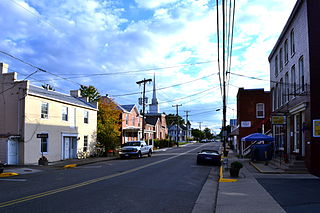
Dayton Historic District is a national historic district located at Dayton, Rockingham County, Virginia, USA. The district encompasses 154 contributing buildings and one contributing site in the central business district and surrounding residential areas of the town of Dayton. It includes a variety of residential, commercial, and institutional buildings most of which date from the late-19th century and early-20th century. Notable buildings include the Alberta Coffman House, Layman House, the Samuel Shrum House, the Thomas House, W.J. Franklin House, Bank of Dayton (1911), the Ruebush-Kieffer Printing Company, Dayton Drug Company, Howe Memorial Hall, the Administration Building (1910), the Kieffer Alumni Gymnasium (1930), Carpenter Store (1888), Specialty Harness Company, Ruebush-Kieffer Company, and the Methodist, Presbyterian, and United Brethren churches.

Edinburg Historic District is a national historic district located at Edinburg, Shenandoah County, Virginia. The district encompasses 292 contributing buildings, 6 contributing sites, 3 contributing structures, and 3 contributing objects in the town of Edinburg. It includes a variety of commercial, residential, and institutional buildings dating primarily from the time of its incorporation in 1852 to the mid-20th century. They are in a variety of popular architectural styles including Colonial Revival, Italianate, and Queen Anne. Notable buildings include the Philip Grandstaff House (1787), Edinburg Hotel, St. John's United Methodist Church (1916), Edinburg High School (1932-1933), Rush House, The Hatch, Piccadilly House (1850), Pres Grandstaff House, Masonic Building (1879), Harshman House (1900), Rest Haven Inn, Edinburg Train Station, Edinburg Village Shops (1896), Wrenn Building, Edinburg Town Hall (1903), St. Paul's United Church of Christ (1911), and the Mantz House (1930). Located in the district is the separately listed Edinburg Mill.

New Market Historic District is a national historic district located at New Market, Shenandoah County, Virginia. The district encompasses 11 contributing buildings in the crossroads town of New Market. It includes a variety of commercial, residential, and institutional buildings dating primarily from 19th century. They are in a variety of popular architectural styles including Victorian, Federal, and Georgian. Notable buildings include the Henkel house, Lee-Jackson Hotel, Solon Henkel House, Salyard House, Rupp House, and Emmanuel Lutheran Church.

Saltville Historic District is a national historic district located at Saltville, Smyth County, Virginia. The district includes 104 contributing buildings and 3 contributing sites in the central business district and surrounding residential areas of Saltville. It includes a variety of residential and commercial buildings primarily dating from the late-19th to mid-20th centuries. Notable buildings and sites include Well Fields, Saltville Golf Course, Office Building (1850), Mathieson Alkali Office Building (1894), company store (1895), First National Bank of Saltville, St. Paul's Episcopal Church (1896), Gothic Revival style Madam Russell Memorial United Methodist Church, Duplex House (1894), Saltville Post Office (1931), Piggly-Wiggly Store, Saltville Savings Bank (1920), and Saltville Town Hall (1949).
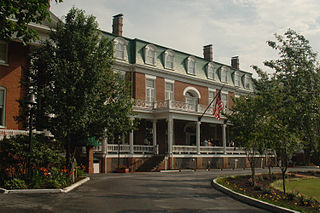
Abingdon Historic District is a national historic district located at Abingdon, Washington County, Virginia. The district encompasses 145 contributing buildings, 2 contributing site, and 13 contributing structures in the town of Abingdon. It includes a variety of residential, commercial, and institutional buildings dating from the late-18th century to the mid-20th century. Notable contributing resources include Sinking Spring Cemetery, William King High School (1913), General Francis Preston House (1832), Martha Washington Inn, Barter Theatre, the Virginia House, Alexander Findlay House (1827), Gabriel Stickley House, Ann Berry House, Washington County Courthouse (1868), Rev. Charles Cummings House, and James Fields House (1857). Located in the district and separately listed are the Abingdon Bank and Dr. William H. Pitts House.
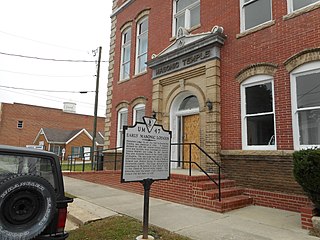
Hicksford–Emporia Historic District, also known as Emporia, is a national historic district located at Emporia, Virginia. The district includes 36 contributing buildings and 2 contributing objects in the Hicksford section of Emporia. In 1848, Hicksford was a stop on the Petersburg Railroad. In 1887, the neighboring towns of Hicksford and Belfield merged to form the town of Emporia. The district generally consists of late 19th century or early 20th century, when Hicksford–Emporia began to evolve from a small agricultural outpost to a large commercial and governmental center. Located at the heart of the district is the separately listed Greensville County Courthouse Complex. Other notable buildings include the Citizen's National Bank, the Widow's Son's Masonic Lodge (1905), First Presbyterian Church (1907-1908), Emporia Elementary School, Emporia Armory (mid-1930s), Greensville County Auditorium (1934), and Emporia Post Office (1938). The Old Merchants and Farmers Bank Building is also separately listed.

Petersburg Old Town Historic District is a national historic district located at Petersburg, Virginia. The district includes 174 contributing buildings located in the oldest section of Petersburg. It includes a varied collection of late 18th- through 20th-century architecture. Notable buildings include the Strachan-Harrison house, the John F. May house, South Side Railroad Depot, High Street United Methodist Church, Church of Christ (1925), and the Powell Manufacturing Co. Located in the district and separately listed are the Appomattox Iron Works, City Market, Exchange Building, Farmers' Bank and Nathaniel Friend House.

Downtown Portsmouth Historic District, also known as the High Street Corridor Historic District, is a national historic district located at Portsmouth, Virginia. It encompasses 229 contributing buildings, 1 contributing site, 4 contributing structures, and 1 contributing object in the central business district of Portsmouth. The district encompasses the original 1752 plan of the Town of Portsmouth and includes portions of expansions of the original boundaries dating to 1763 and 1909. It includes a variety of commercial, government, and institutional buildings, with most dating to the years around the turn of the 20th century. Notable buildings include the Captain Baird House, Vermillion Manor (1840), City Hall Building (1878), former United States Post Office (1907-1908), First Presbyterian Church (1877), First United Methodist Churches (1882), St. James Episcopal Church, Ebenezer Baptist Church, YMCA building, Tidewater Building, Southern Aid Building, Colony Theater, Lyric Theater, Blumberg's Department Store, Mutual Drug Company (1946), the New Kirn Building, and the Professional Building. Separately listed are the Commodore Theatre, Portsmouth Courthouse, Pythian Castle, St. Paul's Catholic Church, and Trinity Episcopal Church
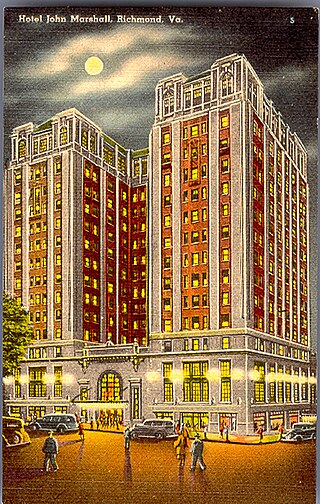
The Grace Street Commercial Historic District is a national historic district located in Richmond, Virginia. The district encompasses 93 contributing buildings located in downtown Richmond. The buildings reflect the core of the city's early 20th-century retail development and the remnants of a 19th-century residential neighborhood. The buildings are in a variety of popular 19th-century and early 20th-century architectural styles, including Classical Revival, Mission Revival, International Style, and Colonial Revival. Notable buildings include the Administration and Equipment Building for the Chesapeake & Potomac Telephone Company (1929), Thalhimer's Department Store, Atlantic Life Building (1950-1959), Miller & Rhoads Department Store, Berry-Burk Building, former W. W. Foster Studios (1927), Bank of Virginia (1949), Investment Realty Company building (1930), W.T. Grant Store (1939), Hotel John Marshall (1927), Franklin Federal Savings and Loan building (1954), and the Tompkins House (1820). Located in the district and separately listed are the Loew's Theatre, Centenary United Methodist Church, Joseph P. Winston House, Central National Bank, and National Theater.
























